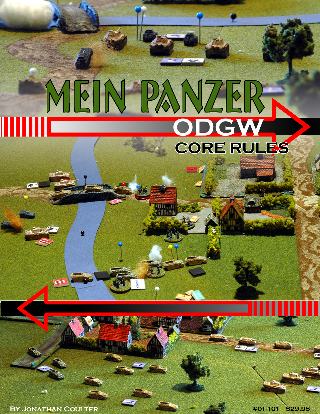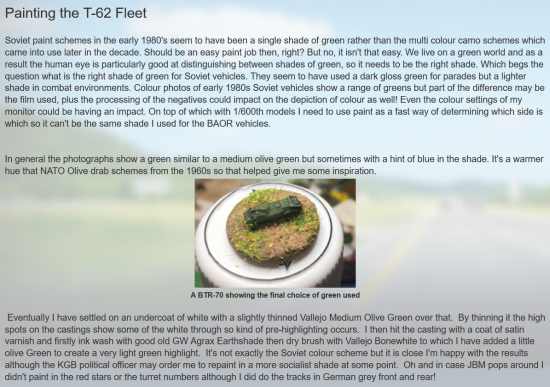
Total Votes: 4
Description
Mein Panzer is a Drop-In Game System, by which the publishers mean that the rules comprise a core set of armor rules plus a series of optional rules modules. Intended as a fast-paced game combining historical accuracy and playability.
The game is played in a series of turns, each of which is composed of several identical phases. At the start of the turn, both players roll to see who goes first. Then, during each phase, both players sequentially may activate one of their units. (In larger games, it is necessary to activate more than one unit per player per phase.)
An activated unit - generally, a platoon - may take both an Action and a Bonus Move. The Action can take place before, after, or during movement, and can be firing, moving, going into overwatch (to wait for opportunity fire), hiding (taking cover), or recovering (clearing misfires, reloading, or recovering from bad morale results). The Bonus Move is simply a movement action - and note that a unit can move twice, by using its Bonus Move plus spending its standard Action on movement.
Units have two movement ratings (cross country and road), and pay a movement penalty for starting any move action in difficult terrain. Rules allow turning in place, pushing, road blocks, and ramming. If a stand moves near an enemy stand, that stand has a chance (based on Troop Quality) to respond with a Reactionary Action (move or fire, once per turn per stand).

A stand's chance to hit is based on its quality, modified by vehicle type (as listed in the equipment charts) and situation (i.e., movement, cover, range, etc.). Some vehicles may take more than one shot per action. If the roll is equal to or less than the modified to-hit number, a hit is scored. Lucky or unlucky rolls result in Critical Hits (bonus damage) or Misfires (dud round, weapon jams, or weapon unusable). Damage is resolved by figuring the Kill Value, determined by firing vehicle's offensive rating and ammo type, and target's defensive value (for front, rear, side, or top), and comparing this on a chart with the results of a dieroll. Possible outcomes are "bounce," suppression, immobilization, and 1 or 2 points of damage. Damaged vehicles suffer penalties to movement and fire, and are destroyed when total damage equals its damage rating. A suppressed stand can take no action until it recovers (required a Recovery Action and a successful Troop Quality roll).
The core rules also cover terrain set-up, deployment, spotting, fields of fire, smoke, tactical reconnaissance, off-board reserves, direct fire of high explosive, and flamethrowers. A point system is provided to aid in scenario design.
Additional "modules," included in the rulebook, allow players to add optional rules according to their interests and scenario needs. These modules are:
- Command and Morale
- Adds unit cohesion and morale rules. A stand becomes "out of command" if too far from another stand in its unit, and loses its Bonus Move. Morale checks are required due to losing a stand in the same unit, seeing another stand withdrawing, or suffering multiple suppression results. A dieroll is made versus Troop Quality, with failure resulting in the loss of one or two morale levels (steady/suppressed/broken/routed). Suppressed and Broken stands may attempt to regain one or two morale levels by taking a Recovery Action.
- Infantry
- Add rules for infantry, covering small arms fire, infantry anti-tank weapons, close combat, assaults vs. vehicles, pinning, cover fire, "penetrating fire" from machineguns, vehicle overruns, and booby traps.
- Transport
- Adds rules for transporting infantry (including tank-borne infantry) and for towing guns. The Transport Tracker Form is provided for keeping track of who is riding within what vehicle. Also covers horses, motorcycles and bicycles.
- Artillery
- Covers on- and off-board artillery, rockets and mortars. An artillery mission may be called in by "legal" forward observers (recon units, headquarters, or dedicated FO stands) or any radio-equipped vehicle (greater possibility of error), using a standard Action. The battery then uses its standard Action to fire a barrage. A dieroll indicates deviation direction and distance (if any). A dieroll is then made for each gun in the battery, and the results compared with the artillery overlay to see where the rounds fall. Rules allow for repeat firing, adjustment of fire, misfires, converged sheaf, smoke, and counter-battery fire.
- Structures
- Allows for fighting within and destruction of structures (buildings and bridges). Includes rules for lighting fires.
- Air Support
- Adds rules for ground support. Aircraft act individually rather than as units, have special movement rules, and must be at one of three altitudes (high/medium/low). In addition to strafing, bombing, and anti-aircraft fire, the rules cover paradrops, aerial observation, gliders, hauling cargo, and forward air controllers. There is a simplified air-to-air combat system, and an optional aircraft damage system that provides added details (i.e., pilot wounded, fuel line hit, etc.).
- Engineering
- Adds rules for combat engineers (and 'dozers). Engineers use supplies in order to construct foxholes, sandbagged positions, entrenchments, bunkers, tank ramps, anti-tank ditches, road blocks, breach obstacles, and to make craters in roads. Includes full rules for bunkers, minefields, demolitions, bridging, and barbed wire.
- Amphibious
- Covers naval landing vessels, from motorboats and rafts to LSTs and mobile docks. Includes rules for preliminary bombardments, coastal defense guns, and a simplified system for exchanging fire between capital ships and shore guns.
- Armored Trains
- Rules for trains, railguns, and derailments.
Crusade at Sidi Rezegh (2 pages) is a sample scenario based on the historical fighting on 21 November 1941 for a critical airfield during Operation Crusader (North Africa). The rulebook also includes a bibliography, index, Transport Tracker form, and a Playsheet (roster).


The data booklet provides vehicle data for France, Germany, Italy, Japan, the Soviet Union, the United Kingdom, and the United States. Over 1000 entries cover tanks, artillery, aircraft, trains, and landing craft. In addition, the following TO&Es are provided:
| France | Armored Division (1939-1940) |
|---|---|
| Germany | Panzer Division (1939-1940) |
| SS Panzer Division (1944-1945) | |
| Italy | Armored Division (1942 North Africa) |
| Japan | Standard Infantry Division (1944-1945) |
| Soviet Union | Tank Brigade (1943-1945) |
| Rifle Division (1943-1945) | |
| United Kingdom | Armoured Division (1942 North Africa) |
| Armoured Division (1944-1945) | |
| United States | Armored Division (1943-1945) |
Editions
First-edition Mein Panzer:













